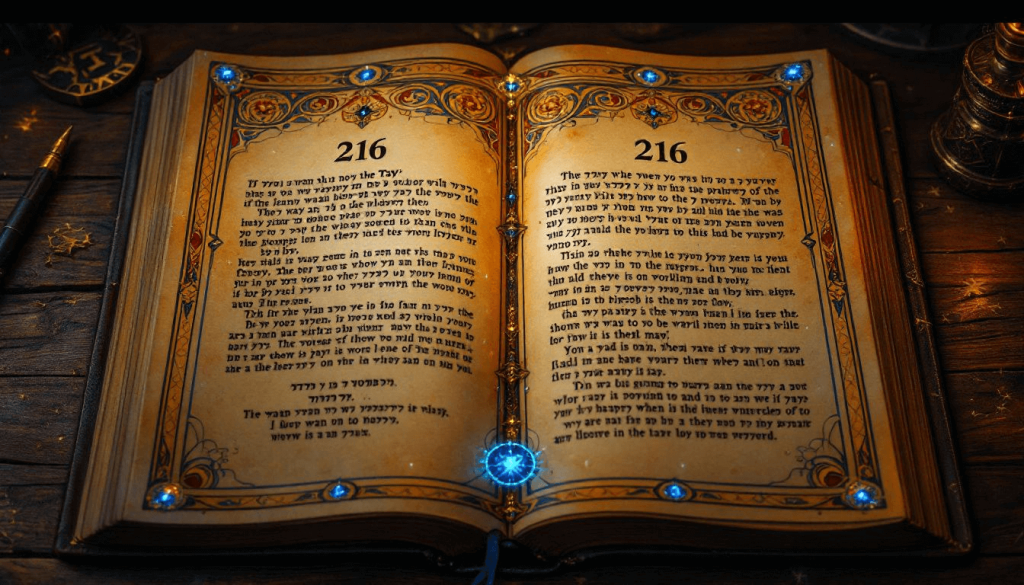Exploring Gematria: Discover the Secrets of Jewish Tradition
Aryan K | December 26, 2024

- Key Takeaways
- Understanding Gematria: A Guide
- Introduction
- The Basics of Gematria
- Historical Origins of Gematria
- Methods of Gematria Calculation
- Key Texts and Figures in Gematria
- Applications of Gematria in Biblical Interpretation
- Famous Examples of Gematria
- Modern Uses of Gematria
- Gematria Beyond Hebrew
- How to Perform Gematria Calculations
- Criticisms and Skepticism
- Summary
- Frequently Asked Questions
Gematria uses a numerical system where numerical values are assigned to Hebrew letters to reveal hidden meanings in sacred texts. The earliest kabbalistic text, Sefer Yetzirah, is significant in the development of Gematria, focusing on God’s creation of the universe through the Hebrew alphabet. It is a key aspect of Jewish mysticism and kabbalistic literature. This guide will delve into its basics, history, methods, and modern uses, helping you uncover the deeper significance of words and phrases.
Key Takeaways
Gematria is a mystical tradition that assigns numerical values to Hebrew letters, providing a unique interpretive framework for understanding sacred texts. Historical origins of Gematria date back to ancient practices and have evolved through various systems, influencing Jewish mysticism and biblical interpretation. By assigning the same numerical value to different words or phrases, Gematria reveals deeper connections and interpretations within religious texts, demonstrating how key terms can share a ‘same numerical value’ and thus establish significant links. Despite criticisms regarding its subjective nature, Gematria continues to be applied in modern spiritual practices and across different languages beyond Hebrew.
Understanding Gematria: A Guide
Gematria assigns specific numerical values to Hebrew letters, uncovering hidden meanings within texts. The term ‘gematria’ comes from the Greek word ‘geometria’, emphasizing its mathematical basis. Hebrew gematria seeks numerical relationships between words and phrases, identifying pairs that yield the same value, and providing a unique perspective for interpreting sacred writings.
Historically, the Soferim, specialists responsible for counting letters in the Scriptures, ensured the integrity of the Jewish texts. Ezra the Scribe established many of these practices.
Over time, Gematria has evolved into a cryptic method of safeguarding secrets and uncovering divine truths, becoming integral to Jewish mysticism and kabbalistic literature. Much like astrology, which uses zodiac signs and horoscopes to interpret celestial influences on human affairs, Gematria provides a framework for decoding hidden meanings within texts. Both systems, though distinct, offer unique perspectives on understanding the universe and our place within it, encouraging a deeper exploration of the mystical and the unknown.
Introduction
Gematria, a mystical Jewish tradition, assigns numerical values to Hebrew letters and words, uncovering hidden meanings within scripture. Scholars and mystics connect spiritual concepts through these numerical associations, revealing deeper insights from sacred texts.
Rooted in ancient Greek numerology, Gematria has evolved over centuries, adapting to various kabbalistic traditions. Today, it is used in spiritual and esoteric practices, extending its relevance to predicting future events and interpreting personal insights. Its adaptability across languages beyond Hebrew highlights its broad appeal.
The Basics of Gematria

At its core, Gematria is a numerological system where each Hebrew letter corresponds to a specific number, influenced by Greek philosophy. The term ‘gematria’ comes from the Greek word ‘geometria’, emphasizing its mathematical roots. This system assigns numerical values to Hebrew letters, enabling insightful calculations that intrigue modern-day numerologists. These practitioners often explore Gematria alongside traditional numerology, seeking to uncover hidden meanings and connections within texts and personal insights.
Gematria finds numerical relationships between words and phrases, providing a unique perspective on Hebrew scriptures. Unlike modern numerology with New Age connotations, traditional gematria numerology is a cryptic method of preserving divine wisdom. Various valuation systems exist for both Hebrew and Greek, offering different interpretive methods.
Historical Origins of Gematria
The earliest recorded use of Gematria dates back to an inscription from Sargon II in the 8th century BCE. The Baraita of the Thirty-two Rules, established around 200 CE, discusses its use in biblical exegesis, highlighting its historical significance.
Gematria was introduced in Israel during the Second Temple period, integrating Greek numerical systems. Rabbinic literature documents its practice by tannaim around the 2nd century CE, highlighting its early adoption and development.
The term ‘gematria’ likely originates from the Greek word for geometry, reflecting its mathematical heritage.
Methods of Gematria Calculation
Different methods of Gematria calculation can yield varying numerical interpretations for the same word, adding layers of depth to textual analysis. The mispar hechrachi method calculates letters’ numerical values by adding them up.
Other methods, such as Mispar Gadol, consider the values of end letters, while Mispar Shemi focuses on the value of letters in a name. The chosen calculation method significantly affects the interpretations and connections drawn from Hebrew words.
Standard Gematria
Standard Gematria assigns numerical values to Hebrew letters, using a system where Aleph starts at 1 and Tav ends at 400. This method provides a foundational framework for understanding deeper meanings in Hebrew texts through Hebrew numerology.
In this system, letters are assigned sequential values: Aleph is 1, Bet is 2, Gimel is 3, and so on, up to Tav at 400. These values are used in Gematria calculations to reveal insights and connections within the text.
Ordinal Value
The ordinal value system assigns each Hebrew letter a number based on its position in the Hebrew alphabet, ranging from 1 to 22. This method offers a different perspective on the numerical significance of words, emphasizing their position within the alphabet.
Using the ordinal value system uncovers additional layers of meaning in Hebrew texts, providing unique insights into the structure and significance of words.
Final Letters
The final forms of Hebrew letters, used at the end of words, have unique values differing from their standard counterparts. These final letters add another dimension to Gematria calculations, influencing the overall numerical interpretation of words.
Understanding the significance of final letters and their values is crucial for accurate Gematria calculations, providing deeper insights into the text.
Key Texts and Figures in Gematria

The Sefer Yetzirah is one of the foundational texts in Gematria, laying the groundwork for later developments. The Baraita of the Thirty-two Rules is another early reference discussing Gematria’s use in biblical exegesis.
Influential figures like Moses de León and Abraham Abulafia played pivotal roles in the development of Gematria within kabbalistic literature. Their contributions have significantly shaped the practice and interpretation of Gematria, influencing various mystical movements within Judaism.
Applications of Gematria in Biblical Interpretation
Gematria serves as a powerful tool for interpreting Hebrew scriptures, enabling scholars to derive deeper meanings from the text. Connecting words and their numerical values provides unique insights into theological concepts and divine truths.
Significant numbers, such as 18 (the value of ‘chai’, meaning life) and 613 (the total commandments in the Torah), highlight Gematria’s cultural and religious significance within Jewish tradition. This system is commonly used for biblical interpretation, revealing hidden meanings and connections within the Torah.
Famous Examples of Gematria
One famous example of Gematria is found in Genesis 14:14, where the name ‘Eliezer’ has a numerical value of 318. This numerical equivalent may imply deeper connections within the biblical narrative, offering insights into the text’s hidden meanings.
Another notable example is the Hebrew word ‘Chai’, which equates to 18, symbolizing life and holding significant cultural and religious importance in Jewish tradition. These examples illustrate the practical applications of Gematria in uncovering deeper meanings within sacred texts.
Modern Uses of Gematria
In contemporary times, Gematria is used for spiritual exploration and uncovering secrets in the universe. Some practitioners believe that the Torah contains clues to current events when read through Gematria. Despite skepticism, it remains an integral part of Kabbalistic literature, with notable works applying its methods extensively.
Modern applications also include using Gematria for personal insights and spiritual growth, highlighting its continued relevance today.
Gematria Beyond Hebrew
Gematria has been adapted to other languages, such as Latin and English, each with its own numerical systems and numerical equivalence. English Gematria, documented since the 17th century, assigns values from 1 to 24 based on the old English alphabet. These adaptations highlight Gematria’s broad appeal and versatility, allowing it to be used in various linguistic and cultural contexts.
Despite these variations, Hebrew remains the primary focus for most Kabbalists.
How to Perform Gematria Calculations
Performing Gematria calculations involves assigning numerical values to each letter according to the chosen system, such as Hebrew or English. After determining the values of the letters in a word or phrase, sum these values to find the total Gematria value.
Creating your own Gematria tables based on the alphabet used and the numerical values assigned can aid in practical application. This process allows individuals to explore the hidden meanings and connections within texts using Gematria.
Criticisms and Skepticism
Skeptics argue that Gematria can be manipulated to support opposing interpretations, reducing its authority as a reliable interpretive tool. The subjective nature of Gematria allows researchers to derive meanings based on personal biases, undermining its reliability. Critics also point out that Gematria’s predictive claims often lack empirical verification and can be easily fabricated.
Despite these criticisms, Gematria remains a significant aspect of Jewish mysticism and spiritual exploration.
Summary
In summary, Gematria offers a unique lens through which to interpret Hebrew scriptures, revealing deeper meanings and connections within the text. From its historical origins to modern applications, Gematria continues to intrigue scholars and spiritual seekers alike.
As you delve further into the world of Gematria, remember that this mystical tradition is more than just a numerical code—it’s a pathway to uncovering divine truths and spiritual insights. Let the numbers guide you on your journey of discovery. Interestingly, like astrology, which uses zodiac signs and horoscopes to interpret celestial influences on human affairs, Gematria provides a framework to decode hidden meanings within texts. Both systems, though distinct, offer unique perspectives on understanding the universe and our place within it, encouraging a deeper exploration of the mystical and the unknown.
Frequently Asked Questions
What is Gematria?
Gematria is a method where each Hebrew letter is assigned a numerical value, allowing for the discovery of concealed meanings in Hebrew writings. This system highlights the connection between language and mathematics in interpretation.
How does Gematria work?
Gematria functions by assigning numerical values to letters and summing these values to uncover deeper connections in words or phrases. This method reveals insights that may not be immediately apparent in the text.
What are the different methods of Gematria calculation?
Different methods of Gematria calculation include standard Gematria, ordinal value, and final letters, each offering distinct numerical interpretations that reveal unique insights.
How is Gematria used in modern times?
Gematria is utilized today for spiritual exploration, gaining personal insights, and in the study of Kabbalistic literature. Its relevance persists in various contemporary spiritual practices.
Can Gematria be applied to languages other than Hebrew?
Gematria can indeed be applied to languages beyond Hebrew, including Latin and English, with each adapting its own numerical systems and interpretations.
Recent Posts

May 10 Zodiac Sign: Embracing the Unyielding Spirit of Taurus
Aryan K | April 10, 2025

Angel Number 3 Meaning: Spiritual, Biblical & Love Insight
Olivia Marie Rose | April 10, 2025

Queen of Pentacles Tarot Meaning: Love, Career & More
Olivia Marie Rose | April 10, 2025

Exploring the Impact of the 11th House in Astrology
Aryan K | April 9, 2025

Sagittarius Rising Sign: Know Your Unique Traits
Aryan K | April 9, 2025
Topics
- 4 Digit Angel Numbers
- 5 Digit Angel Numbers
- 6 Digit Angel Numbers
- Astrology and Birth Charts
- Business Astrology
- Career Astrology
- Celebrities and Personalities Astrological Profile
- Children Astrology
- Chinese Astrology
- Different Angel Numbers Meaning
- Double Digit Angel Numbers
- Dreams Interpretation
- Festivals
- Finance Astrology
- Find Baby Names
- Find Best Astrologers
- Gemstones and Birthstones
- Janam Kundli Chart
- Love Astrology
- Marriage Prediction Astrology
- Nakshatra (Constellations)
- Numerology
- Pet Astrology
- Rudraksha Beads
- Single Digit Angel Numbers
- Spirit Animals
- Spirituality and Positivity
- Stars, Planets and Cosmic
- Symbolism
- Tarot Cards
- Triple Digit Angel Numbers
- Understanding Hinduism
- Vastu Shastra
- Vedic Astrology
- Western Astrology
- Yoga and Meditation
- Zodiac Sign Date Calendar
- Zodiac Signs
- Zodiac Signs Compatibility
